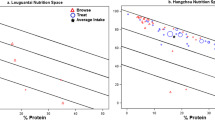Abstract
The natural and provisioned (wheat) food intake of the Japanese monkeys on Koshima was measured by direct observation. It was found that the portion of wheat consumed reflects such social structures in Japanese monkeys as (a) the structure of cocentric circles composed of several classes, (b) female ranking orders, (c) social strictness in breeding or non-breeding seasons.
The natural food intake forIcho (2–3 years old female) was estimated for three seasons (April, September and December) during 1971. Her daily caloric intake was estimated from a quantitative list of natural foods eaten and the quantity of wheat eaten by multiplying the appropriate caloric values, and digestibility of 70%. The kcal day per values were 411 in spring, 522 in summer and 559 in winter. Her daily energy consumption (DEC) was estimated to be 398, 423, and 447 kcal/day in the respective seasons derived from the equation DEC =153W2/3 which was obtained from data on activity telemetry and basal metabolic rates. The two spring values are in agreement. The summer and winter values show considerable differences.
The dependency on wheat was calculated for individuals of various ages and sexes. The dependency of juveniles (60%) is about double that of ordinary females (25%).
The Koshima troop is largely dependent on the evergreen broad leaves through all seasons.
The increase of the number of females was cumulatively simulated assuming constant age-specific fecundity and mortality. There appeared one stagnated period of increase during the years 1961–1964 due to external factors. It will be a future problem to relate the quality of nutrition to reproductive performance.
Similar content being viewed by others
References
Asahi, M., 1971. On the adaptability of Japanese monkey to the cold climate, II.Ann. Rep. Primat. Res. Inst., Kyoto Univ. 1: 30.
Calhoun, J. B., 1963.The Ecology of the Norway Rat. Bethesda, Maryland, pp. 136.
Chiba, A., 1970. The measurement of secondary productivity in Japanese serow in captivity. JIBP-PT—Interim Rep. of Subalpine Conifer Forest,Kitazawa (ed.), pp. 180–195.
Edie, J., 1969. Sheep production and pastral resources. In:Animal Population in Relation to Their Food Resources,Watson (ed.), Blackwell Scientific Publications, Oxford & Edinburgh, pp. 7–24.
Golley, F. B., 1959. Tables of caloric equivalents.Mimeo. Univ. of Georgia, pp. 1–7.
——, 1961 Energy values of ecological materials.Ecology, 42: 581–584.
——, 1965. Structure of an old-field broom sedge community.Ecol. Monogr., 35: 113–131.
——, 1969. Caloric value of wet tropical vegetation.Ecology, 50: 517–519.
Hara, M., 1971. On the adaptability of Japanese monkey to the cold climate, I.Ann. Rep. Primat. Res. Inst., Kyoto Univ., 1: 30.
Hazama, N., 1962. Population dynamics and measurements of body weight of Japanese monkey in Arashiyama.Report of the Study on the Natural History of the Mt. Iwatayama 1: 1–54. (in Japanese)
Itani, J., 1954. Japanese monkeys in Takasakiyama. In:Nihon Dobutsuki, II,K. Imanishi (ed.), Kobunsha, Tokyo, pp. 242. (in Japanese)
--, 1956. Foods of wild Japanese monkeys—case of the Takasakiyama troop—Rep. Primat. res. group, 1–14. (in Japanese)
——, 1958. Japanese monkeys on Koshima Islet. In:Nihon Dobutsuki, III,K. Imanishi (ed.), Kobunsha, Tokyo, pp. 242. (in Japanese)
Kawai, M., 1965. Newly-acquired pre-cultural behavior of the natural troop of Japanese monkey on Koshima island.Primates, 6: 1–30.
——, 1969.Ecology of Japanese Monkey. Kawadeshobo, Tokyo, pp. 300. (in Japanese)
--,S. Ando, U. Mito, Y. Ono, & K. Higashi, 1970. The measurement of activity of wild Japanese monkeys.Proc. 17th Ann. Meet. Ecol. Soc. Japan, p. 84. (in Japanese)
Ovington, J. D. &D. Heitkamp, 1960. The accumulation of energy in forest plantation in Britain.J. Ecol. 48: 639–646.
——, 1967. Comparative chlorophyll and energy studies of prairie, savannah, oakwood and maize field ecosystems.Ecology, 48: 515–524.
Petrusewicz, K. & Macfadyen, 1970. Productivity of terrestrial animals.Principle and Method (IBP Handbook No. 13), 106–111.
Spector, W. S., 1966.Handbook of Biological Data. W.B. Sanders, Philadelphia, pp. 285, 347.
Sugiyama, Y., 1960. On the division of natural troop of Japanese monkeys at Takasakiyama.Primates 2: 109–148.
Suzuki, A., 1965. An ecological study of wild Japanese monkey in snowy areas—Focused on their food habits.Primates 6: 31–72.
Wada, K., 1964. Some observations on the monkeys in a snowy district of Japan.Seiri Seitai (Physiology and Ecology), 12: 151–174. (in Japanese)
Watson, A. &R. Moss, 1969. Dominance, spacing behaviour, and aggression. In:Animal Population in Relation to Their Food Resources A. Watson (ed.), Blackwell Scientific Publications, Oxford & Edinburgh, pp. 165–220.
Grozinski, W. &K. S. Kapsta, 1970. Energy value of plant eaten by birds.Oikos 21: 52–58.
Author information
Authors and Affiliations
About this article
Cite this article
Iwamoto, T. A bioeconomic study on a provisioned troop of Japanese monkeys (Macaca fuscata fuscata) at koshima islet, Miyazaki. Primates 15, 241–262 (1974). https://doi.org/10.1007/BF01742286
Received:
Accepted:
Issue Date:
DOI: https://doi.org/10.1007/BF01742286




